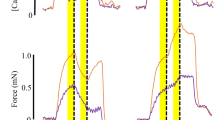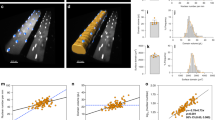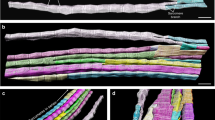Abstract
VARIOUS properties of the Ca2+-activated troponin system are different in red (slow twitch) and white (fast twitch) muscle; these differences are in molecular weight1,2, amino acid sequences of the subunits3, Ca2+ binding to troponin4,2, and biochemical measures of contraction (actomyosin ATPase activity and superprecipitation4,7). Although the preceding differences have been investigated, no report on physiological differences in Ca2+-activated tension have been published. We compared the development of Ca2+-activated tension in an oxidative muscle fibre (soleus) and that in a glycolytic muscle fibre (adductor magnus) of the rabbit from embryo to adult. We used a technique recently developed in our laboratory5 for mechanically disrupting the sarcolemma of skeletal muscle fibres. We then examined the data, in view of the known biochemical differences, for possible clues to the roles that troponins have in the Ca2+ sensitivity of the various types of muscle.
This is a preview of subscription content, access via your institution
Access options
Subscribe to this journal
Receive 51 print issues and online access
$199.00 per year
only $3.90 per issue
Buy this article
- Purchase on Springer Link
- Instant access to full article PDF
Prices may be subject to local taxes which are calculated during checkout
Similar content being viewed by others
References
Syska, H., et al., FEBS Lett., 40, 253–257 (1974).
Dabrowska, R., et al., FEBS Lett., 29, 239–242 (1973).
Van Eerd, J., Biochem. biophys. Res. Commun., 64, 122–127 (1975).
Ebashi, S., et al., J. Biochem., 64, 465–477 (1968).
Kerrick, W. G. L., and Krasner, B., J. appl. Physiol., 39, 1052–1055 (1975).
Hellam, D. C., and Podolsky, R. J., J. Physiol., Lond., 200, 807–819 (1969).
Ebashi, S., et al., Q. Rev. Biophys., 2, 351–384 (1969).
Donaldson, S. K. B., and Kerrick, W. G. L., J. gen. Physiol., 66, 427–444 (1975).
Tsukui, R., and Ebashi, S., J. Biochem., 73, 1119–1121 (1973).
Masaki, T., and Yoshizaki, C., J. Biochem., 76, 123–131 (1974).
Szent-Györgyi, A. G., et al., J. molec. Biol., 74, 179–203 (1973).
Haselgrove, J. G., thesis, Univ. Cambridge (1970).
Huxley, H. E., Cold Spring Harb. Symp. quant. Bio., 37, 361–376 (1973).
Chaplain, R. A., and Gergs, V., Biochem. biophys. Res. Commun., 61, 517–524 (1974).
Morimoto, K., and Harrington, W. F., J. molec. Biol., 88, 693–709 (1974).
Sreter, F., et al., J. Cell Biol., 55, 586–594 (1972).
Author information
Authors and Affiliations
Rights and permissions
About this article
Cite this article
KERRICK, W., SECRIST, D., COBY, R. et al. Development of difference between red and white muscles in sensitivity to Ca2+ in the rabbit from embryo to adult. Nature 260, 440–441 (1976). https://doi.org/10.1038/260440a0
Received:
Accepted:
Issue Date:
DOI: https://doi.org/10.1038/260440a0
This article is cited by
-
Calcium and the role of motoneuronal doublets in skeletal muscle control
European Biophysics Journal (2009)
-
Discrimination of Ca2+-ATPase activity of the sarcoplasmic reticulum from actomyosin-type ATPase activity of myofibrils in skinned mammalian skeletal muscle fibres: distinct effects of cyclopiazonic acid on the two ATPase activities
Journal of Muscle Research and Cell Motility (1991)
-
Calcium sensitivity and myofibrillar protein isoforms of rat skinned skeletal muscle fibres
Pfl�gers Archiv European Journal of Physiology (1990)
-
Calcium and strontium activation characteristics of skeletal muscle fibres from the small marsupialSminthopsis macroura
Journal of Muscle Research and Cell Motility (1990)
-
Compared properties of the contractile system of skinned slow and fast rat muscle fibres
Pfl�gers Archiv European Journal of Physiology (1989)
Comments
By submitting a comment you agree to abide by our Terms and Community Guidelines. If you find something abusive or that does not comply with our terms or guidelines please flag it as inappropriate.



